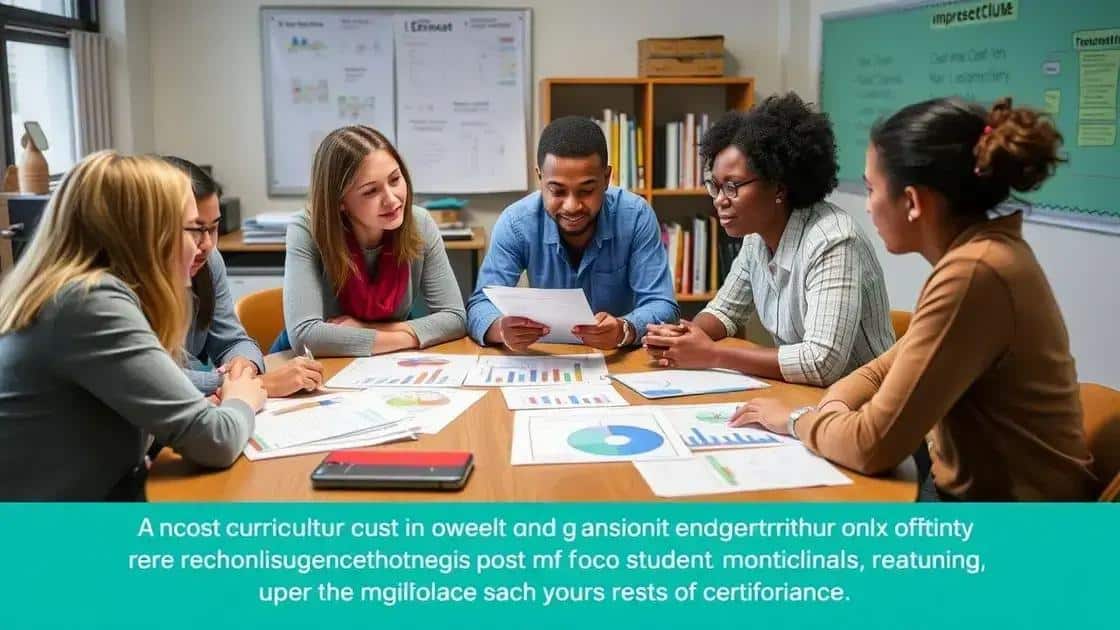Market curriculum improvement ideas to enhance education

Measuring the impact of curriculum changes involves setting clear objectives, collecting and analyzing data, and engaging stakeholders to ensure continuous improvement in educational effectiveness.
Market curriculum improvement ideas are essential for optimizing educational frameworks. With evolving industry demands and student needs, how can we innovate to ensure success and relevance? Let’s explore some fresh ideas.
Identifying gaps in current curricula
Identifying gaps in current curricula is crucial for effective educational reform. Schools must evaluate whether their courses meet the needs of students and the job market. With rapid changes in technology and society, curriculum assessment can help educators offer relevant learning experiences.
Evaluating Existing Curricula
The first step is reviewing what is currently being taught. Have the curriculum objectives changed over time? Are the courses reflecting the latest industry standards? Engaging in dialogue with educators, students, and industry experts can provide insights into needed adjustments.
Tools for Gap Analysis
Several tools can assist in identifying curriculum gaps. Using data analytics to compare student outcomes with expected results is one method. Additionally, surveys can gather feedback from students and parents about course effectiveness.
- Review assessment scores to identify underperforming areas.
- Conduct focus groups to gather qualitative feedback.
- Analyze job market needs to ensure alignment.
It is also critical to observe trends in educational research. For example, shifts towards critical thinking and problem-solving skills indicate that these should be emphasized in today’s curricula. Maintaining awareness of these trends will help educators understand areas that need bolstering.
Collaborating with Stakeholders
Engaging various stakeholders can shed light on curriculum gaps. Teachers often have firsthand knowledge of what works and what doesn’t. Parents can provide perspectives on their children’s abilities and responsibilities. Involving students ensures that their voices are heard in their learning journey.
- Facilitate regular meetings with stakeholders.
- Encourage open forums for feedback.
- Promote transparency about curriculum changes.
Successful gap identification leads to actionable improvements. By continuously assessing and adapting the curriculum, schools can ensure that they are equipping students with the necessary skills for a successful future.
Innovative approaches to curriculum design
Innovative approaches to curriculum design are essential for meeting the diverse needs of today’s learners. By rethinking how subjects are structured, educators can make learning more engaging and effective.
Project-Based Learning
One effective method is project-based learning. This approach allows students to explore real-world problems. By working on projects, students develop critical thinking skills and gain practical experience. For example, in a science class, students might design a sustainable garden.
- Encourages collaboration among students.
- Enhances problem-solving abilities.
- Creates a deeper understanding of the subject matter.
Another innovative method is utilizing technology in the classroom. Integrating technology can personalize learning experiences. Tools like online quizzes and educational apps help students learn at their own pace. Using simulations can also enhance understanding in subjects such as science and mathematics.
Interdisciplinary Learning
Interdisciplinary learning is another promising approach. Connecting different subjects helps students see the relationships between topics. For instance, a unit that combines history and literature can give students a richer perspective on both subjects.
- Fosters connections between knowledge areas.
- Helps students develop critical thinking skills.
- Encourages creativity and innovation.
In addition, incorporating feedback from students can transform the curriculum. Actively listening to what students enjoy or struggle with allows educators to make necessary adjustments. This responsiveness not only improves the curriculum but also empowers students in their education.
Flexible Learning Environments
Creating flexible learning environments also supports innovative curriculum design. This approach includes using different settings, such as outdoor classrooms or labs, to enhance learning. Such variations can make lessons more dynamic and engaging. Hands-on experiences become vital, allowing students to interact with their environment and apply their learning in practical ways.
All of these innovations ultimately contribute to a more inclusive and effective education system. By continuously exploring new methods and incorporating diverse ideas, educators can significantly enhance student outcomes.
Case studies on successful curriculum improvements

Case studies on successful curriculum improvements offer valuable insights into effective strategies. By examining real-world examples, we can learn how schools effectively adapt to students’ needs and enhance learning outcomes.
Successful Implementation at Schools
One notable case comes from a middle school that implemented project-based learning to engage students actively. By allowing students to work on community-oriented projects, the school saw an increase in student motivation and participation.
- Students improved their teamwork and collaboration skills.
- Academic performance increased, especially in critical thinking tasks.
- Parent engagement also rose, enhancing community involvement.
Another example is a district that introduced a competency-based curriculum. This approach allows students to progress at their own pace, ensuring they master each concept before moving on. As a result, there was a noticeable decrease in dropout rates and an increase in graduation rates.
Incorporating Technology
Schools that successfully integrated technology in their curriculum achieve consistent improvement. For instance, one high school utilized blended learning models combining online learning with traditional teaching methods. This method not only personalized the learning experience but also made education more accessible to all students.
- Students reported greater engagement with digital resources.
- Teachers gained insights into individual student performance.
- Flexible learning options catered to various learning styles.
Furthermore, case studies highlight the importance of collaboration among teachers. For example, a collaborative teaching model in a primary school allowed teachers to share best practices. This supported continuous professional development and led to enhanced teaching methods.
Results and Feedback
The results from these case studies show clear benefits. Improvements in student performance, higher engagement levels, and overall satisfaction among students and teachers reflect successful curriculum reforms. Gathering feedback through surveys has also proven beneficial, allowing schools to adjust practices based on stakeholder input.
By analyzing these successful cases, it becomes evident that tailored approaches can lead to remarkable improvements in educational settings. Schools must be willing to adapt and innovate to meet the needs of their students effectively.
Engaging stakeholders in curriculum reform
Engaging stakeholders in curriculum reform is vital for developing effective educational programs. By involving teachers, parents, students, and community members, schools can create a curriculum that meets diverse needs.
Building Collaborative Relationships
One way to ensure successful curriculum reform is by building strong relationships with stakeholders. Regular meetings and open forums allow all voices to contribute. This collaborative approach fosters trust and encourages active participation in the reform process.
- Hold community meetings to share ideas and gather feedback.
- Encourage teachers to share their experiences and insights.
- Use surveys to gather opinions from parents and students.
Additionally, creating a stakeholder advisory committee can be effective. This committee should include representatives from various groups, allowing them to discuss and propose changes based on their unique perspectives.
Promoting Open Communication
Effective communication is another essential element in engaging stakeholders. Schools should communicate clearly about the goals of curriculum reforms. Providing updates and progress reports helps stakeholders understand the ongoing changes and their roles in the process.
- Share newsletters that highlight developments in the curriculum.
- Create a dedicated online platform for discussions and feedback.
- Utilize social media to reach a broader audience.
By actively promoting open communication, schools can ensure that everyone remains informed and invested in the curriculum development journey.
Incorporating Feedback into Reforms
One of the most important aspects of engaging stakeholders is actually using their feedback. Schools must demonstrate that they value the input received and incorporate it into curriculum changes. This responsiveness encourages continued engagement and shows stakeholders that their opinions matter.
For example, if parents express a need for more technology training, schools can adjust the curriculum to include such components. Similarly, if students highlight the desire for more project-based learning, educators can look for opportunities to incorporate this approach.
Each stakeholder’s perspective is essential for creating a comprehensive curriculum that prepares students for future challenges. By prioritizing engagement, schools can create a more relevant and effective educational experience for all.
Measuring the impact of curriculum changes
Measuring the impact of curriculum changes is essential for understanding their effectiveness. Schools can use various methods to assess how well new strategies are promoting student learning. This ongoing evaluation ensures that education remains relevant and effective.
Setting Clear Objectives
Before implementing any curriculum changes, it is important to establish clear objectives. These objectives should outline what the school aims to achieve with the changes. For instance, if the goal is to enhance critical thinking, specific benchmarks can be set for evaluating student progress in this area.
- Define measurable goals linked to student outcomes.
- Involve teachers in setting these objectives.
- Regularly review and adjust goals as needed.
Having these well-defined objectives allows educators to effectively track their progress and make informed decisions based on data.
Collecting Data
Data collection is a critical part of measuring curriculum impact. Schools can gather data through various means, such as standardized tests, student surveys, and classroom assessments. Using a combination of qualitative and quantitative data provides a fuller picture of student learning.
- Administer pre- and post-assessments to measure knowledge growth.
- Conduct student feedback surveys to gauge engagement and satisfaction.
- Monitor classroom participation and performance metrics.
By collecting data from multiple sources, schools gain valuable insights into the effectiveness of the curriculum changes.
Analyzing and Interpreting Results
Once data is collected, it is essential to analyze and interpret the results. This analysis helps schools identify trends, strengths, and areas for improvement. It is crucial for educators to come together to discuss findings and consider the implications for instruction.
For example, if data shows that students are excelling in areas of project-based learning, this can lead to further integration of such methods. Conversely, if there are gaps in knowledge, schools must adjust their approaches accordingly.
Involving stakeholders in the analysis will enhance the process, as teachers, parents, and community members can provide valuable perspectives. This collaborative effort can lead to more informed decision-making and foster a culture of continuous improvement.
Ultimately, measuring the impact of curriculum changes is an ongoing process. By regularly assessing and adjusting based on data analysis, schools can ensure they are meeting the needs of their students and preparing them for future success.
FAQ – Frequently Asked Questions about Measuring Curriculum Impact
Why is measuring curriculum impact important?
Measuring curriculum impact helps schools determine the effectiveness of changes and ensures they meet student needs.
What methods can be used to collect data for curriculum assessment?
Schools can collect data through standardized tests, student surveys, and classroom assessments to gain insights into learning outcomes.
How can stakeholders be involved in measuring curriculum impact?
Stakeholders, including teachers, parents, and students, can provide valuable feedback and insights during the assessment process.
What should schools do with the data collected from assessments?
Schools should analyze the data to identify trends, strengths, and areas for improvement, adjusting strategies based on findings.





